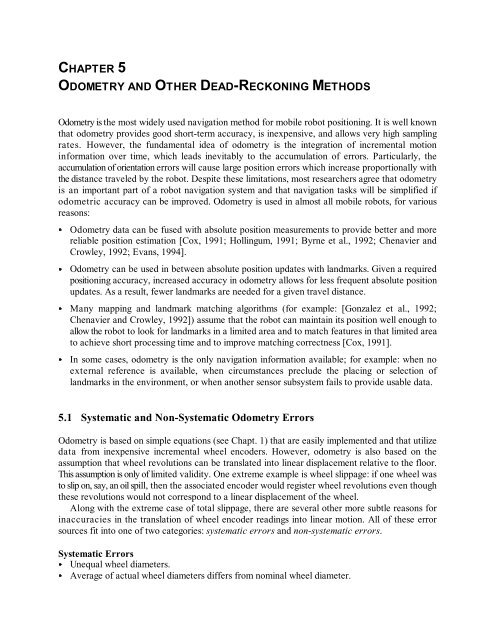Where am I? Sensors and Methods for Mobile Robot Positioning
Where am I? Sensors and Methods for Mobile Robot Positioning
Where am I? Sensors and Methods for Mobile Robot Positioning
Create successful ePaper yourself
Turn your PDF publications into a flip-book with our unique Google optimized e-Paper software.
CHAPTER 5<br />
ODOMETRY AND OTHER DEAD-RECKONING METHODS<br />
Odometry is the most widely used navigation method <strong>for</strong> mobile robot positioning. It is well known<br />
that odometry provides good short-term accuracy, is inexpensive, <strong>and</strong> allows very high s<strong>am</strong>pling<br />
rates. However, the fund<strong>am</strong>ental idea of odometry is the integration of incremental motion<br />
in<strong>for</strong>mation over time, which leads inevitably to the accumulation of errors. Particularly, the<br />
accumulation of orientation errors will cause large position errors which increase proportionally with<br />
the distance traveled by the robot. Despite these limitations, most researchers agree that odometry<br />
is an important part of a robot navigation system <strong>and</strong> that navigation tasks will be simplified if<br />
odometric accuracy can be improved. Odometry is used in almost all mobile robots, <strong>for</strong> various<br />
reasons:<br />
&<br />
&<br />
Odometry data can be fused with absolute position measurements to provide better <strong>and</strong> more<br />
reliable position estimation [Cox, 1991; Hollingum, 1991; Byrne et al., 1992; Chenavier <strong>and</strong><br />
Crowley, 1992; Evans, 1994].<br />
Odometry can be used in between absolute position updates with l<strong>and</strong>marks. Given a required<br />
positioning accuracy, increased accuracy in odometry allows <strong>for</strong> less frequent absolute position<br />
updates. As a result, fewer l<strong>and</strong>marks are needed <strong>for</strong> a given travel distance.<br />
& Many mapping <strong>and</strong> l<strong>and</strong>mark matching algorithms (<strong>for</strong> ex<strong>am</strong>ple: [Gonzalez et al., 1992;<br />
Chenavier <strong>and</strong> Crowley, 1992]) assume that the robot can maintain its position well enough to<br />
allow the robot to look <strong>for</strong> l<strong>and</strong>marks in a limited area <strong>and</strong> to match features in that limited area<br />
to achieve short processing time <strong>and</strong> to improve matching correctness [Cox, 1991].<br />
&<br />
In some cases, odometry is the only navigation in<strong>for</strong>mation available; <strong>for</strong> ex<strong>am</strong>ple: when no<br />
external reference is available, when circumstances preclude the placing or selection of<br />
l<strong>and</strong>marks in the environment, or when another sensor subsystem fails to provide usable data.<br />
5.1 Systematic <strong>and</strong> Non-Systematic Odometry Errors<br />
Odometry is based on simple equations (see Chapt. 1) that are easily implemented <strong>and</strong> that utilize<br />
data from inexpensive incremental wheel encoders. However, odometry is also based on the<br />
assumption that wheel revolutions can be translated into linear displacement relative to the floor.<br />
This assumption is only of limited validity. One extreme ex<strong>am</strong>ple is wheel slippage: if one wheel was<br />
to slip on, say, an oil spill, then the associated encoder would register wheel revolutions even though<br />
these revolutions would not correspond to a linear displacement of the wheel.<br />
Along with the extreme case of total slippage, there are several other more subtle reasons <strong>for</strong><br />
inaccuracies in the translation of wheel encoder readings into linear motion. All of these error<br />
sources fit into one of two categories: systematic errors <strong>and</strong> non-systematic errors.<br />
Systematic Errors<br />
& Unequal wheel di<strong>am</strong>eters.<br />
& Average of actual wheel di<strong>am</strong>eters differs from nominal wheel di<strong>am</strong>eter.

















